Growers Blog
White Pine Weevil is Not a Big Deal (as long as you do something about it)
You notice that an evergreen on your property is turning brown on the tip. You point it out to your neighbor and he says, “That thing has borers; it’s junk”. Have you ever heard this? This statement is wrong for two reasons. One, the culprit is not a borer, it’s a weevil. Two, the tree can be amended with just a few well-placed prunes.
The damage in question is not caused by a borer (which is a large beetle with robust grub-like larvae) it is caused by the white pine weevil. They are small beetles (0.2”) with an elephant-like snout. They have mottled coloration from light to dark brown, often with some whitish patches. It is a native insect, and is merely fulfilling its role in our ecosystem. Weevils frequently cause damage on: white pine, Swiss stone pine, Serbian spruce, Oriental spruce, blue spruce, and Norway spruce. They can occasionally affect other pines and spruces as well.
The adult female emerges from the leaf litter in early spring and makes her way to the tip of a suitable host tree to feed, mate, and deposit her eggs. Selected trees are usually between 3’ and 20’ tall, and are usually growing in full sun. Trees growing in sun have fatter, more stable leaders which provide a safer, more spacious home for the larvae.
After mating, clutches of 1-5 eggs are laid within 10” of the tip of the terminal leader. Hundreds of eggs can be deposited on a single leader. In about a week, the larvae will hatch -tiny grubs which are maggot-sized. They encircle the stem and chew their way down the trunk, just underneath the bark. You may start to see the leader wilting as sufficient water can no longer make it up to the tip of the trees. Once the grubs are mature enough and far enough down the leader for their feeding tunnels to intersect each other, all flow of water to the leader is completely cut off and the tip turns brown.
Now is the time to act. If you had noticed tiny resin droplets shortly after the eggs were laid in early May, you could have pruned it out then, or if you had noticed the tip beginning to wilt in late May to June, you could have pruned it then. But most of us don’t notice until the tip turns obviously brown, and that’s okay – you can fix it.
Prune out the damaged leader down to the next healthy whorl of branches. Depending on the extent of the feeding, you may be removing just the central leader, or you may need to remove the leader as well as the uppermost whorl completely. You want to make sure you cut below the damage into healthy stem. Keep making prunes lower and lower until your cut reveals a green ring of healthy tissue completely encircling the stem, with no signs of larvae tunnels or excrement. Remove anything that is left to just a couple inches above the healthy branches.
Now that you have eliminated the pests, you can select a new leader. If you do not select a single leader to be dominant, then you will end up with one of those wild, sprawling multi-trunked pines which are prone to storm damage- referred to as cabbage or wolf pines. Wolf pines are valuable in out nature, providing an entire ecosystem in just one tree; but in your landscape they may be less desirable for aesthetic reasons. Look at the remaining branches on what is now your top whorl. Decide which is the strongest, and remove all the others. There is no need for a stake- the branch will straighten up as the new leader within a matter of weeks. It’s a very easy fix, and really nothing to worry about, especially on smaller trees. Of course, it’s a bit more difficult on a 16’ tree, but a pair of pole pruners will help with that.
There are chemical methods to prevent weevil damage, but unless you own a Christmas tree farm then a damaged leader is not worth the money, effort, or environmental impact to prevent. In fact, removing the leader causes the lower parts of the tree to thicken up and will result in a denser tree in the future. An 8-10’ evergreen which you buy in a nursery has been topped at least 3 times for this exact reason. So don’t worry about a bit of weevil damage in your landscape. White pine weevil is not a big deal (as long as you do something about it).
ADDITIONAL INFORMATION:
https://www.youtube.com/watch?v=XykmZCSfrI4
https://extension.unh.edu/resource/white-pine-weevil-fact-sheet
https://www.maine.gov/dacf/mfs/forest_health/insects/white_pine_weevil.htm
https://extension.psu.edu/white-pine-weevil
https://www.seacoastonline.com/story/news/local/york-star/2019/01/03/weevil-attacks-wolf-pines-are/6394235007/
_________________________________________________________________________________________________________________________
Why do you have this but not that?
While everyone in the horticulture industry loves plants, the main goal of a successful business is to be profitable. Some plants just aren’t profitable to grow,
no matter how much you like them.
-Nut trees have very deep roots which makes harvesting difficult: black walnut and butternut, shagbark and pignut hickories
 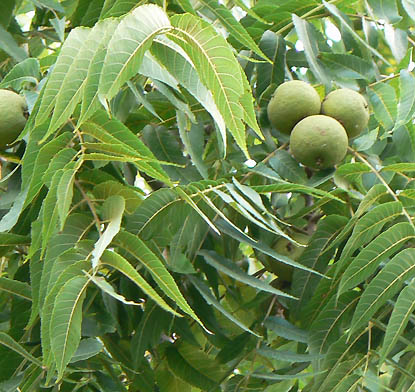
-Native woodland plants need a native woodland to grow, performing poorly in open fields: hobblebush viburnum, maple-leaf viburnum, huckleberry, sassafras
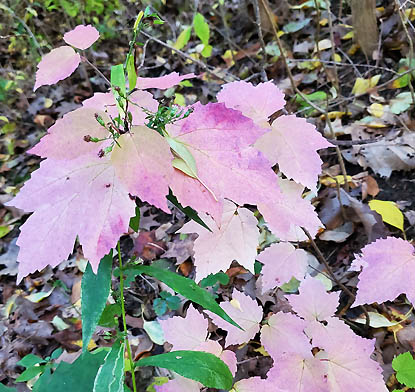 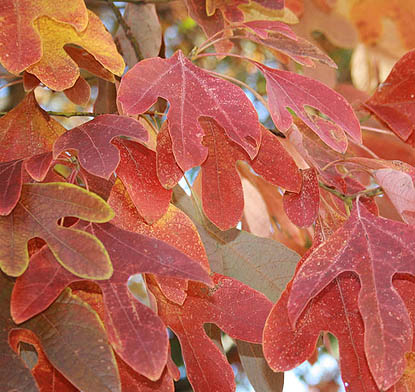
-Some plants have very shallow roots which don’t grow well in heavy clay soils. They tend to topple over in exposed tree fields or result in a very weak, wiggly tree in the rootball. Growth is also very slow when young, adding a year or two to production, which reduces profitability: pitch pines, Japanese black pines
 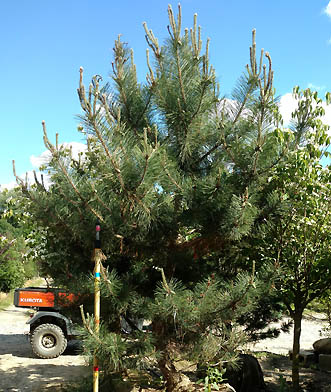
-Plants which are at the northern tip of their hardiness range are available in limited numbers: peach, fruiting cherry, Franklinia, pawpaw, persimmon, Cryptomeria. Some are so tender for us that we don’t even bother with them: Leyland cypress, skip laurel, crepe myrtle
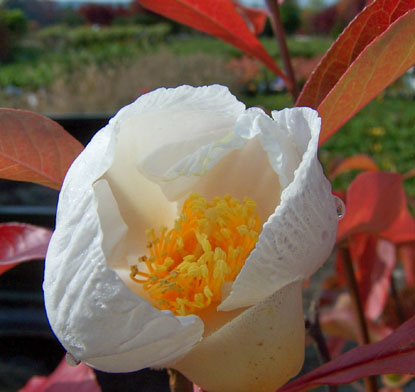 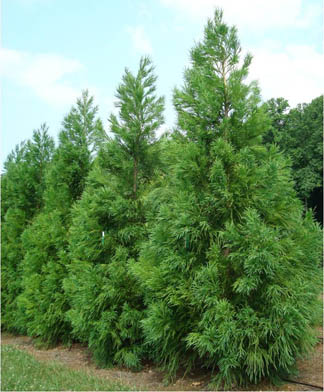
-Some native trees have so many pathogens and pests that growing a healthy one is not economically feasible: black cherry, mountain ash
 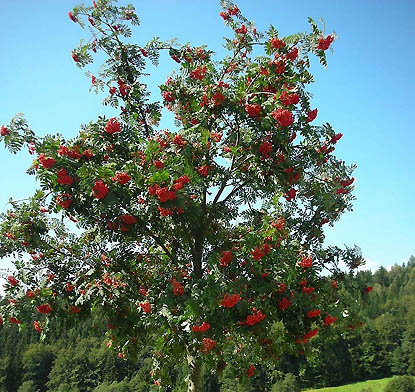
Growers are going to produce plants which are profitable in large numbers; things like Red Maples, Arborvitaes, Kousa Dogwoods, Apple Trees, European Hornbeams, Boxwoods. Plants which are less profitable are grown as novelties to be used as a single specimen. We may have a few of each in the spring, but don’t expect to get 20 of them....ever!
_____________________________________________________________________________________________
The order of things
When you make a living off of nature, there is a certain order you must follow in order to keep your business as profitable as possible. We are often asked questions like: “When will the fruit trees be in?” or “When do you anticipate the arrival of white pines?” This is a general timeline of what arrives when.
Most large wholesale growers grow everything they can; deciduous trees and shrubs, evergreen trees and shrubs, and container shrubs and perennials. Deciduous plants being field dug in ball and burlap must be harvested first. They need to be dug before the leaves emerge. From March 1st through most of April our deciduous plants arrive. Once the leaves have emerged, the harvest window for them is closed and it’s time to move on. The next step is to dig evergreen trees and shrubs. The second half of April and all of May we unload one evergreen truck after another. They can be dug until their new growth emerges in June. Large Rhododendron and Kalmia arrive in late May and June as well. Once the harvest times have closed for digging field plants, it’s time to concentrate on container plants, which can be shipped continually. Container shrubs arrive in May, June, and can be continually restocked throughout the season. Perennials arrive in mid May with new shipments regularly arriving every two weeks until fall.
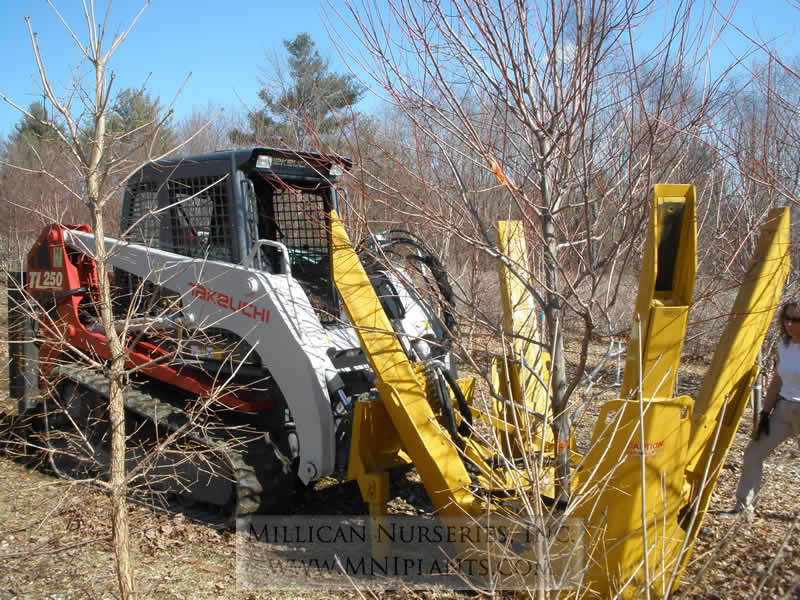
_____________________________________________________________________________________________
How to reduce populations of viburnum leaf beetle in your landscape
Viburnum Leaf Beetle (VLB) is native to Europe and Asia. Its introduction to North America occurred in Montreal in the late 1940's and the population has been slowly moving south since then. They have become well-established in our forests, so completely eliminating them isn't going to happen anytime soon, but a well-timed shearing will do wonders to reduce the populations on the plants in your landscape.
In late summer to early fall, adult beetles chew rows of small craters in the tender stems from the past season's growth. In each crater they lay 6 or so eggs, then cover them with a cap made from chewed bark and excrement. Each adult beetle can lay up to 500 eggs, so the population can get out of control very quickly without proper management. The hatched larvae can quickly defoliate your plants and if this occurrs for a few seasons in a row, your Viburnums may perish.
After the eggs are layed in October and before they hatch in May is the time to go on the offensive. Most egg-laying sites are located on the outer 6-8" of the plant. Shearing off this outer growth will go a long way in removing the majority of the of these thousands of leaf-chewing critters. Make sure you dispose of the clippings either by burning them or sending them to the landfill as composting them may not prevent the eggs from hatching.
More VLB's will come back in the future, but if you save your Viburnum pruning for late fall or early spring, then you will have fewer insects and more leaves to show for it!
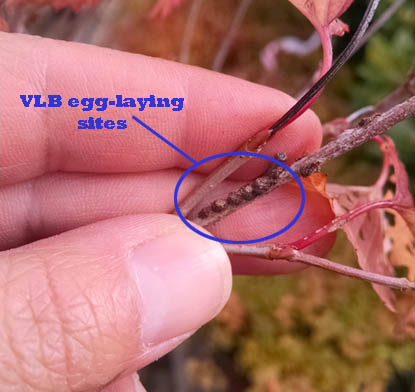
Additional Reading:
http://www.hort.cornell.edu/vlb/
http://entnemdept.ufl.edu/creatures/orn/beetles/viburnum_leaf_beetle.htm
_____________________________________________________________________________________________
Why is fall the best time to plant a new tree?
Most people think that the hardest season for a tree is the winter, but that’s not true. The tree is dormant in winter, so doesn’t care what’s going on around it. The most stressful time for a tree is the summer. Lack of water during summer dry spells is the biggest limiting factor in a plant’s growth. In order to battle the lack of water, a tree needs a good root system that can seek out water in the soil when the sky isn’t supplying it.
Root growth occurs most in spring and fall with warm days and cool nights. By planting in the spring, you get one round of root growth before the tree has to deal with all the stresses of summer. When you plant in fall, you get two rounds of root growth before the heat of summer sets in. By planting in fall, you ensure that the root system is twice as strong as it would be if you had planted in spring. That’s why fall is the best time to plant.
There is one catch though: availability of trees in fall is much lower than they are in spring. So fall is the best time to plant, but spring is the best time to get exactly what you want. Fall planting requires flexibility in plant options. If you can be flexible on what you want, then you will have a healthier tree to show for it come next summer. Our sales staff would be happy to help you find other options that fit your wants and needs in a tree. Happy planting!!
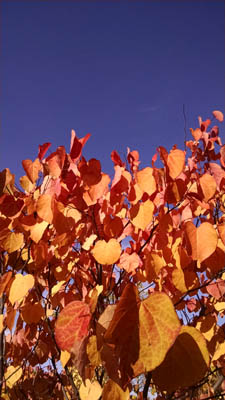 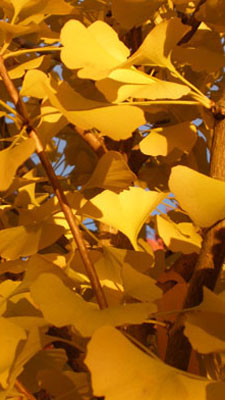 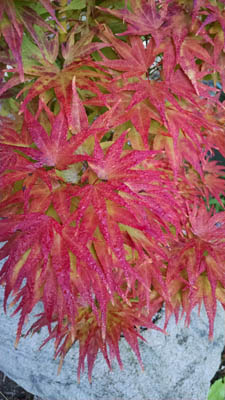
____________________________________________________________________________________________
The life of an evergreen
Ever wonder how cones form on an evergreen tree? Here's a little peek into the life cycle of a conifer cone. These photos are of the cones on Abies koreana 'Horstman's Silberlocke', but any needled evergreen tree will have similar structures.
Each evergreen tree produces two different types of cones -male cones and female cones. The bottom portion of the tree produces male cones, while the upper portion of the plant produces female cones. This reduces the chances of the tree pollinating itself which isn't exactly bad, but if trees continually pollinate themselves, then genetic deficiencies will eventually become apparent.
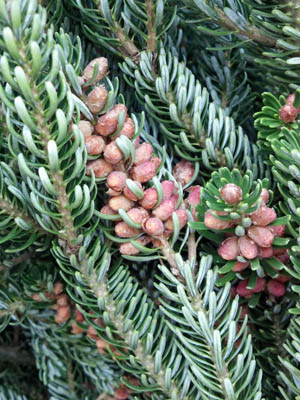
Male cones, like those pictured above, produce pollen and then fall of the tree shortly after. They typically are colored pink to red depending on the species. The pollen is blown by spring winds from these male cones on the lower portion of the tree to the upper portion of a neighboring tree. There the pollen settles on the sticky surfaces of the female cones like those pictured below. Female cones are typically green or pink to purple.
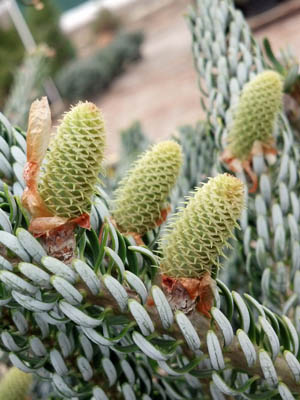
Each scale of the cone can produce two small, winged seeds (similar in appearance to a Maple samara, commonly called a "helicopter") if adequately pollinated. Once mature, in anywhere from 3 months to 3 years depending on the type of tree, the cone scales open up exposing the seeds to be blown away by the wind to settle on the ground and produce a new tree.
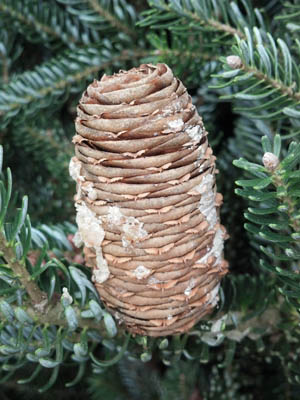
Generally, people don't think about evergreens as having flowers, but when these cone structures are in peak production in spring, they can be very colorful and eye-catching, even if only for a brief period of the growing season.
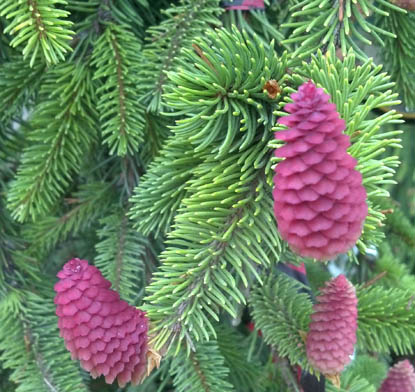
Picea abies 'Pendula' Female Cones
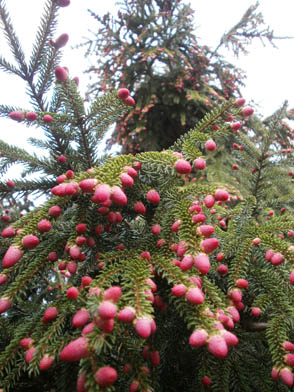
Picea orientalis 'Gowdy' Male Cones
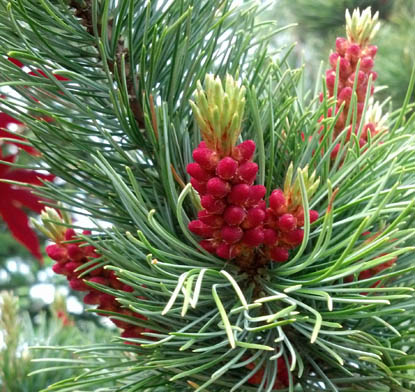
Pinus parviflora 'Bergmani' Male Cones
Many Pine trees have evolved to use fire to open the cones and expose the seeds. Our native Pitch Pine as well as Ponderosa Pine in the Western US are the two most well-known trees to take advantage of fire as a means of promoting reproduction.
_____________________________________________________________________________________________
Proper siting of broadleaf evergreens
We have taken many calls recently regarding winter injury to broadleaf evergreens like Kalmia (Mountain Laurel) and Rhododendrons. Here are a few helpful hints to prevent this from happening to your plants.
In winter, the jet stream pulls cold, dry, arctic air in from Canada. These winds come from the northwest. Make sure broadleaf evergreens are sheltered from these brutal winds. They dry out the leaves, and the frozen ground prevents the plants from replacing the water that has been lost.
The sun is closest to the earth during our winter months. This means the sunlight we do receive in winter is more intense than in the summer months. Broadleaf evergreen leaves can be scorched by afternoon sun. In the perfect scenario, they would receive full morning sun, and afternoon shade ...which can only be provided by evergreens or buildings in winter. Keep in mind when planting these beautiful shrubs in summer that deciduous leaves will be gone in winter and what may be a shady spot during the growing season, may be in full blazing sun all winter.
In most cases, as long as the stems have not dried out, the brown leaves will fall off and the plants will leaf out again. Rhododendrons can be completely defoliated by leaf scorch, but have their buds unaffected. Many times the large flower buds may dry up and fall off, but the smaller leaf buds remain in tact. Give your plants a little time to recover after a severe winter, and they may surprise you with their resiliency.
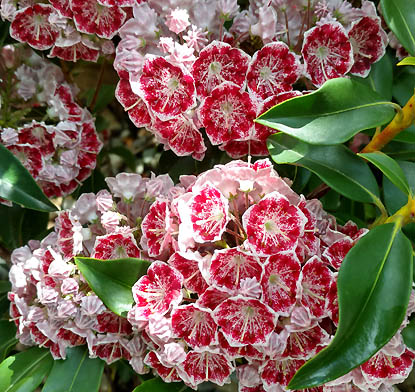 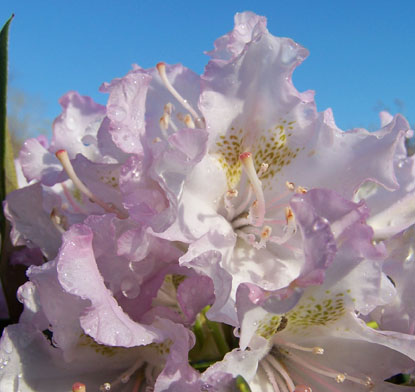
|













